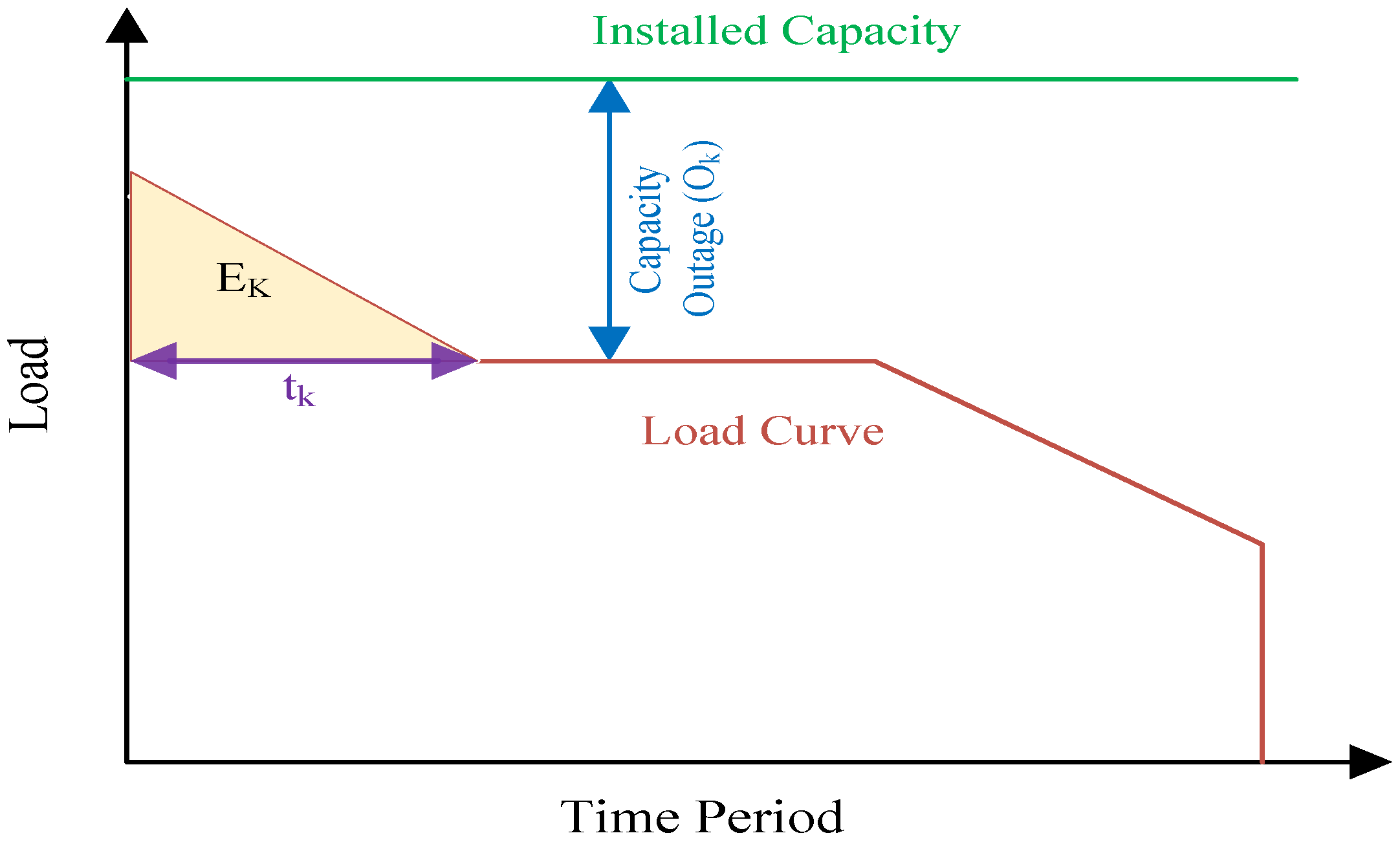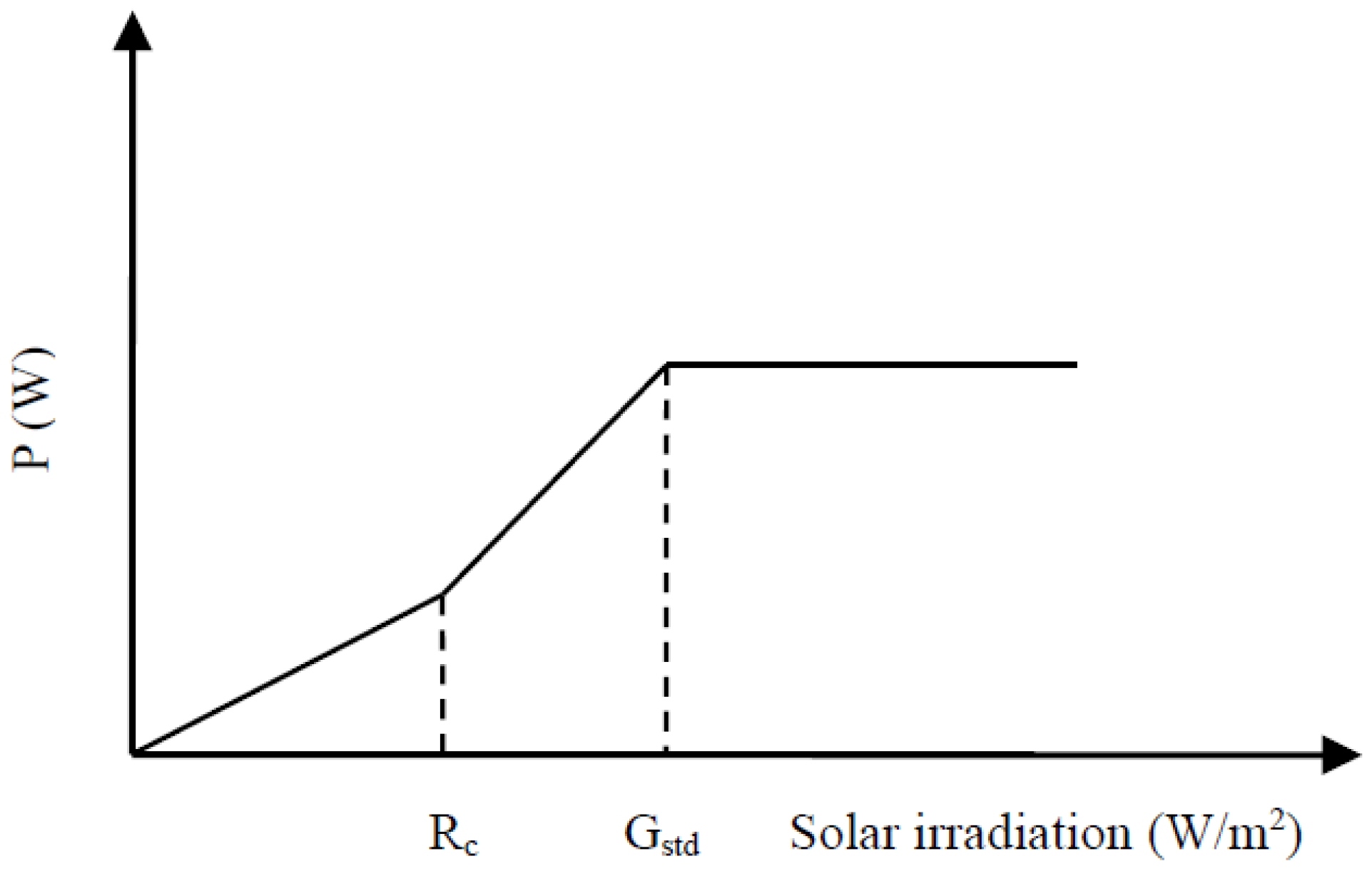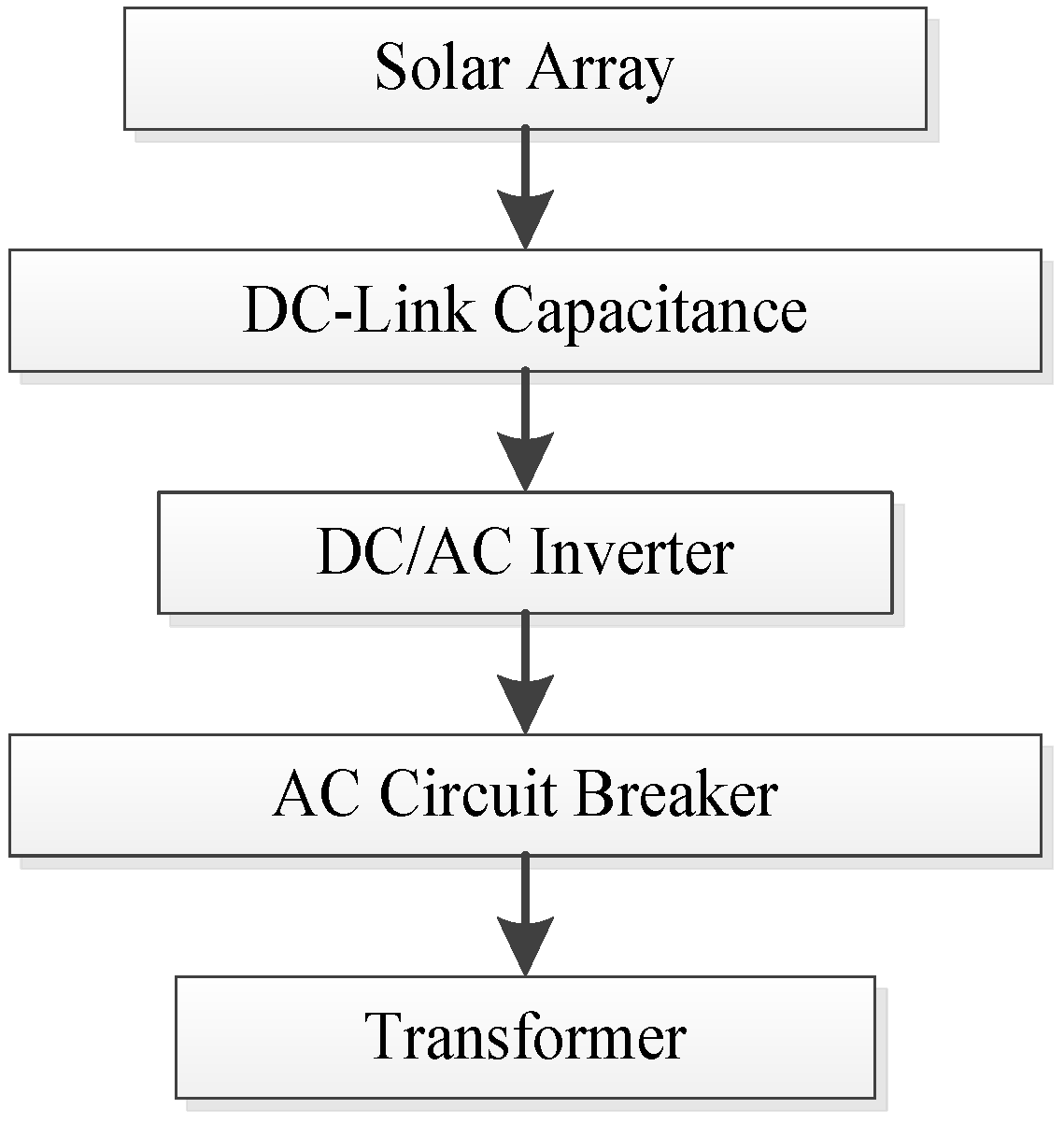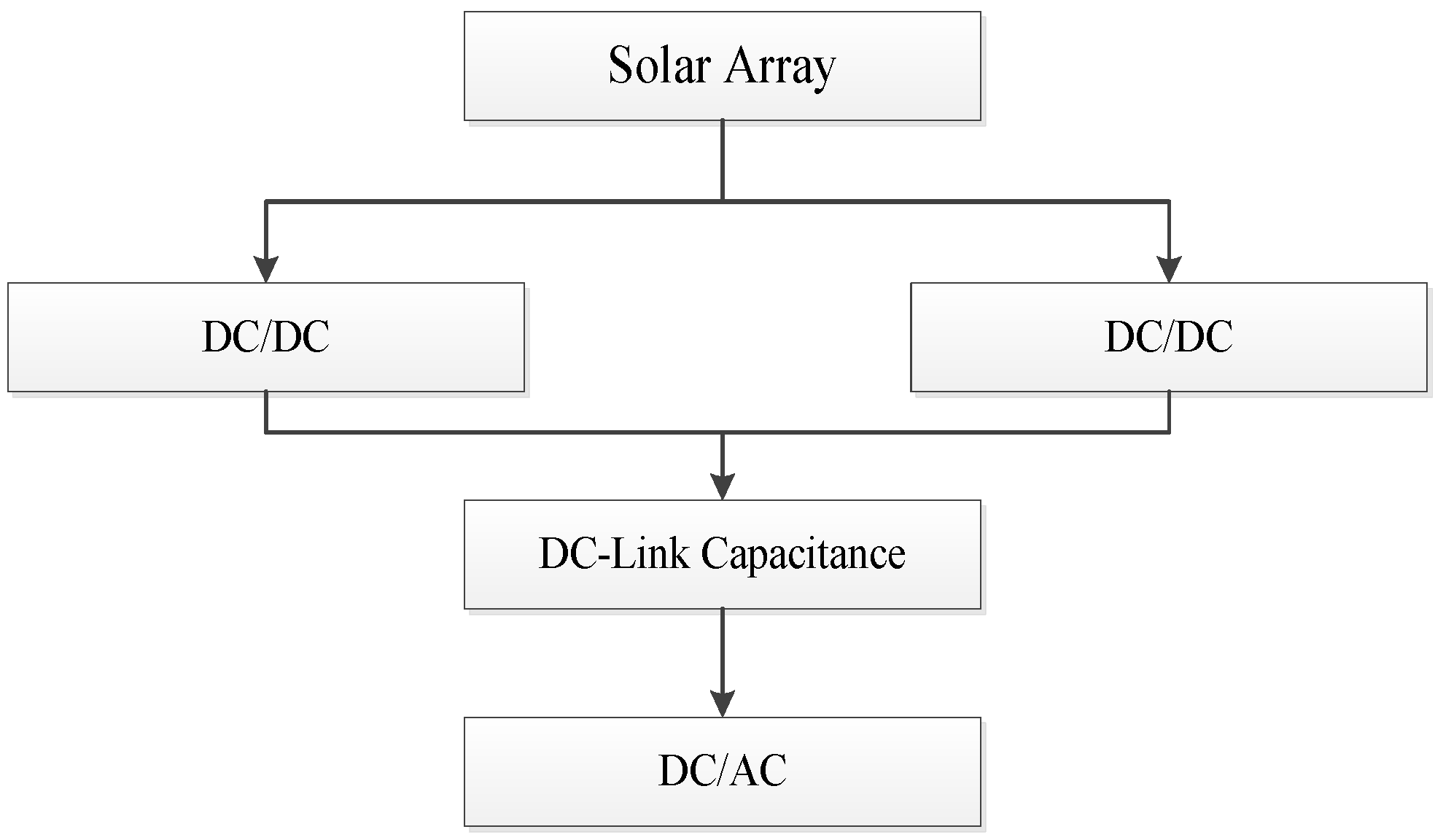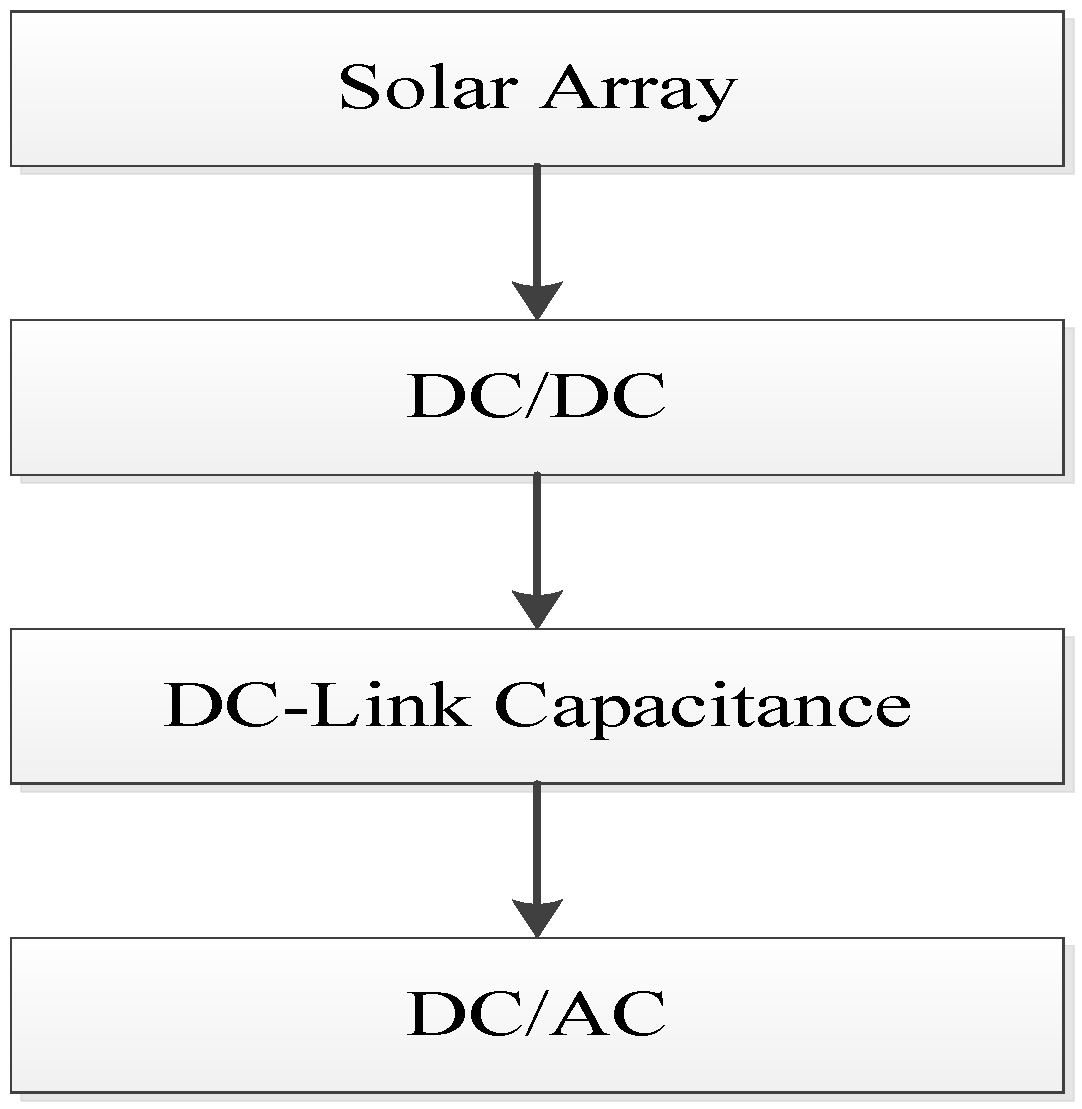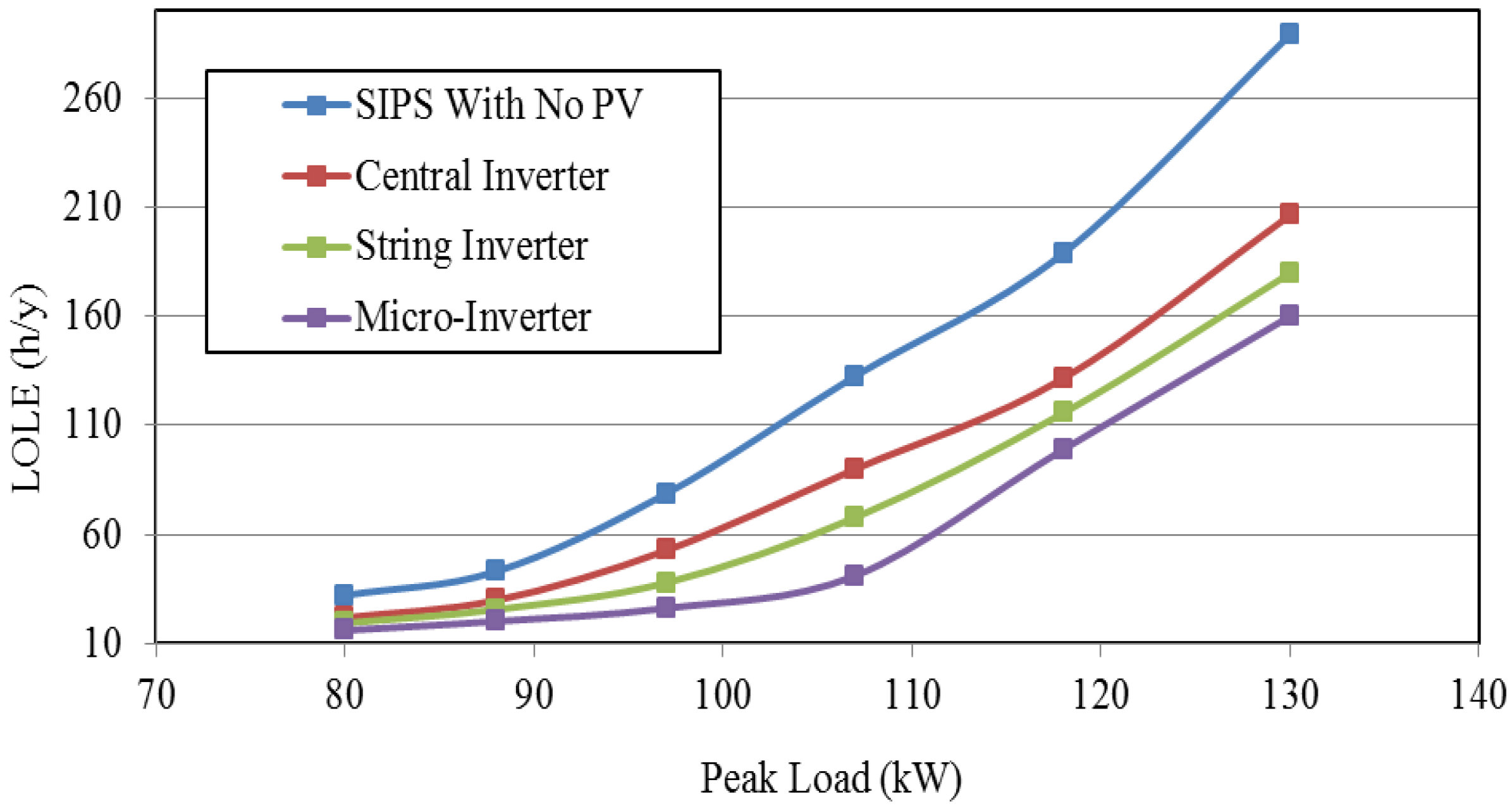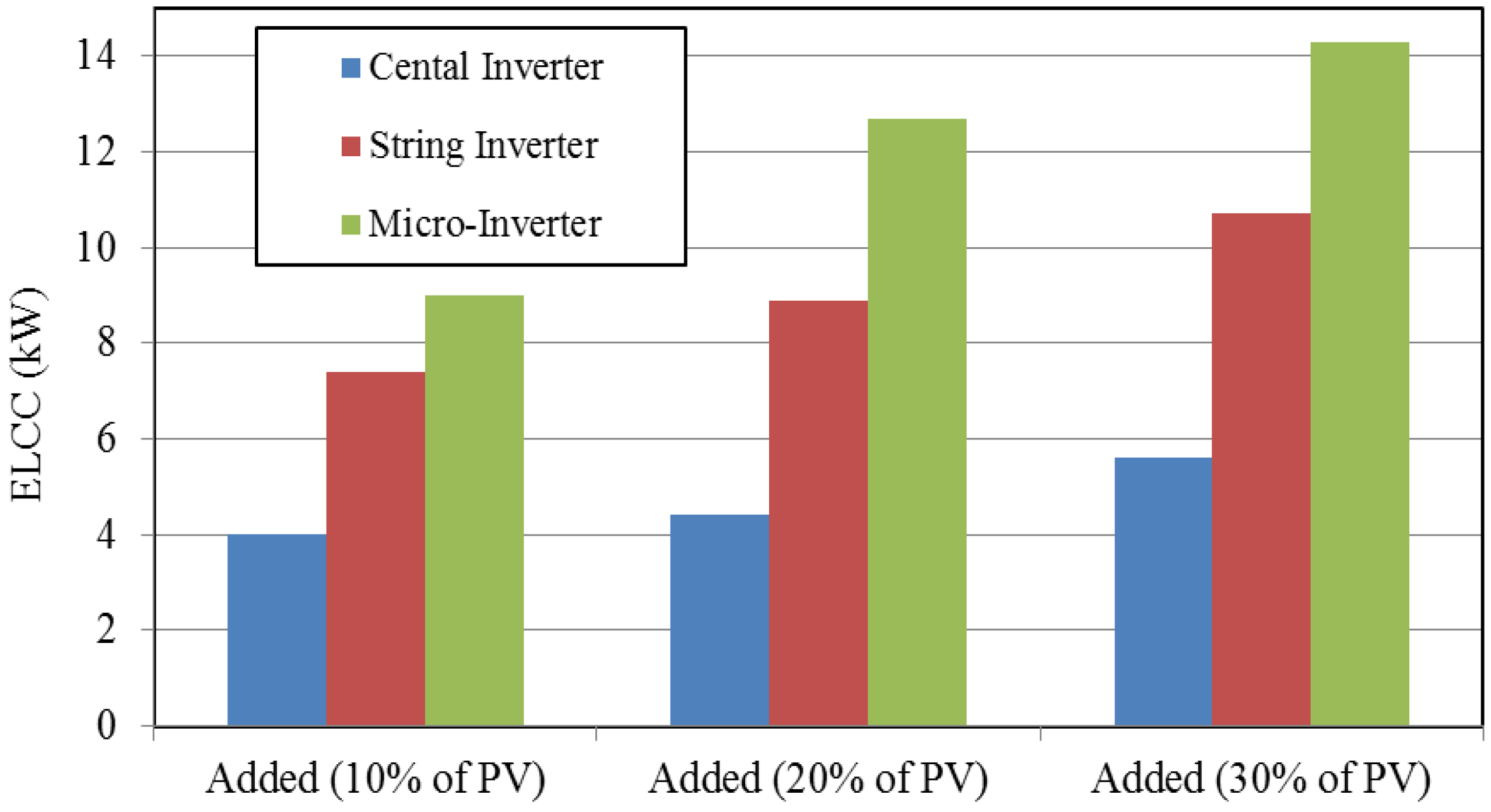Developing a generation model of the overall system generation including the output power of the PV system and conventional generation is required. In this step, the failure rates of critical components in the PV system, such as capacitance and switching, are taken into consideration. Secondly, the developed generation model is then combined with an hourly load model to evaluate system adequacy as shown in
Figure 1. In this work, the central, string and micro PV inverter system topologies and the output power of solar cell are taken into consideration in reliability modeling of overall PV system.
Section three presents a clear framework for developing an overall reliability model of PV system. There are three types of system-level reliability models: part-count, combination and state-space models. Part-count is utilized in this project since this model can provide adequate reliability estimation. Three assumptions are taken into account to apply this model.
3.1. Modeling Solar Cell
The analytical model used in evaluating the power output of solar cells depends on two main factors: solar cell efficiency and solar cell irradiation. The efficiency of a solar cell varies with the amount of solar irradiation, and it can be evaluated using Equations (8) and (9) [
15]. The power output from a solar cell can be calculated using Equations (10)–(12), as shown in
Figure 5 [
15].
where
P is the power output of the solar cell (W);
Gbi is global solar irradiation (W/m
2);
Gstd is solar irradiation in a standard environment set as 1000 (W/m
2);
Rc is a certain irradiation point set as 150 (W/m
2); and
Psn is the equivalent rated capacity of PV (W). The approach described in
Figure 5 is used to create the multi-state model of the power output of the solar cell. The multi-state model is obtained by dividing the solar irradiation into segments. A step size of 50 W/m
2 is used to create these segments. The number of obtained states from these segments is 22 states. Zero solar irradiation is used as an individual state. To calculate the probability for given states, Equation (13) is created, where
Ni is the number of occurrences of each state of
i:
The model is applied to an example system considering historical solar irradiation data of Al-Madinah located in Saudi Arabia [
16]. The data include solar irradiation at five-minute intervals from 2000 to 2005 for different sites [
16]. The total collected data of solar irradiation at five-minute intervals for five years is 525,600 samples. The power output of the solar cell device depicted in
Table 1 is in per unit (pu) and was created using Equations (10)–(13). The probability of zero output is 0.4774. In this work, different PV capacities are considered to assess the reliability contribution of the PV system.
3.2. Reliability Modeling of a Central PV System
The multi-state model shown in
Table 1 is combined with a two-state model of central PV system components described in this section. The main components of a typical central PV system are illustrated in
Figure 6. This central PV system consists of a solar array, bulk DC-link capacitance, inverter, line filter, AC switch, AC circuit breaker and transformer. The reliability analysis can be performed at the component level or system level. The functional block diagram of this PV system is shown in
Figure 7.
The reliability research of power electronic components has focused on failure rate models of conductors, capacitors and magnetic devices [
17,
18]. However, field experience has demonstrated that electrolytic capacitors and switch devices are the most vulnerable components [
19]. There are several reliability models available for power electronic and high power voltage. MIL-HDBK-271F second edition is the military handbook for reliability component prediction for power electronic components [
20]. This handbook provides an extensive reliability database for power electronic components. This database is used in this work to evaluate the failure rate of power electronic components. Then, the results of this step are used in the reliability analysis at the system level.
➢ Solar panel
Solar panels consist of solar cells. These solar cells have a very low failure rate. Most manufactures offer a warranty from 20 to 25 years on their solar module [
21] and have demonstrated very high reliability in the field with mean time between failure (MTBF) of 522 and 6666 years for residential and utility systems, respectively [
22]. The effect of PV architecture on the overall system reliability is therefore not considered on this work.
➢ DC-link Capacitor
The failure rate of capacitors is considered one of the major factors leading to the failure of PV systems. Capacitances can be made of different materials such as an electrolytic capacitor, paper, plastic film, tantalum and ceramic [
23]. Each material has a different failure rate [
23]. The electrolytic capacitor is used in this work. The inductance is not considered since it has a low failure rate [
24]. Equations (14)–(16) are used to evaluate the failure rate of capacitance (
λcap) [
25,
26,
27], where
n is the total number of components in the system;
λbase is the base failure rate of capacitance and equal to 0.0314 occur/year;
πE is the effect of environmental stress and is equal to 1;
πQ is the quality factor and is equal to 1;
C is the capacitance value in microfarad (µF); and
Tj is the junction temperature, which is 50 °C. The total failure rate of DC-link capacitor is 0.4449 occur/year.
➢ Inverter
The MTBF of PV-inverter is between 1 to 16 years [
22]. Inverter is considered as another major factor leading the failure of PV systems. A three-phase two-level voltage-source inverter is used in this work. This inverter has six switches and diodes. This work does not treat the inverter as one black-box. Each component inside the inverter is considered a major factor in failure. The Reliability Block Diagram (RBD) [
28,
29] is used in this project. This technique involves the use of switches and diodes connected in series, and this is known as series RBD as shown in
Figure 4. The failure rate of the inverter (
λinv) can be evaluated using Equation (17). Equations (18)–(21) are used to evaluate the failure rates of diodes (
λdiode) [
25,
26,
27].
where
n is the total number of components in the system;
λbase is the base failure rate of diodes and is equal to 0.025 occur/year;
πE is equal to 6;
πS is the electric stress factor; the operating voltage and rated voltages are 607 V and 690 V, respectively;
πQ is equal to 5.5;
πj is the temperature stress factor;
Tj is equal to 50 °C; and
πc is the contact construction factor, which is 1. Equations (22) and (21) are used to evaluate the failure rates of the switches (
λswitch) [
25,
26,
27].
where
λbase is the base failure rate of the switches, which is 0.012 occur/year;
πE is equal to 1;
πQ is equal to 5.5; and
Tj is equal to 50 °C. The total failure rate of inverter is 0.095 occur/year.
➢ AC Circuit Breaker and Transformer
The reliability database provided by [
30] is used to calculate the probability of success and failure of these components.
The reliability data of common PV system components are shown in
Table 2. The probability of up and Down states of a central PV system is shown in
Table 3. Then,
Table 3 is combined with
Table 1 to build the overall central PV system model. This model represents the multi-state model of the power output of a central PV system including the component failure factors.
3.3. Reliability Modeling of a String Inverter PV System
As noted earlier, the schematic construction of a PV inverter plays an important role in the power output of a PV system. A typical PV inverter system as illustrated in
Figure 8 is used in this work. In this design, each string inverter will produce 10 kW, so five string inverters are required to produce 30% of the total installed capacity. The functional block diagram of this PV system is shown in
Figure 9.
➢ DC/DC Converter
The boost converter used in this work has one switch, two diodes and one capacitance. The two DC/DC converters are considered in redundancy. This work does not treat the converter as one black-box. Each component inside the converter is considered as a major factor in failure. RBD [
28,
29] is used in this section. The failure rate of the converter (
λDC/DC) can be defined using Equation (24). The prediction methodology used to evaluate the failure rate of each component can be found in MIL-HDBK-217F second edition [
20]. Equations (18)–(23) are used to evaluate the failure rates of
λdiode and
λswitch [
25,
26,
27], where
Tj is 60 °C.
➢ DC-Link Capacitor
As mentioned, the capacitor is recognized as a major contributor to the failure of PV systems. Equations (12)–(14) are utilized to estimate the failure rate of capacitance (
λcap) [
25,
26,
27]. The probability of Up states and Down states of a string PV inverter system is shown in
Table 4. This table is then combined with
Table 1 to build the multi-states model for one string PV system. This model represents the multi-state model of the power output of a string PV system including the component failure factors. Multiple string PV system is used in this work; therefore, the multi-states model obtained are aggregated to obtain the desire PV capacity.

